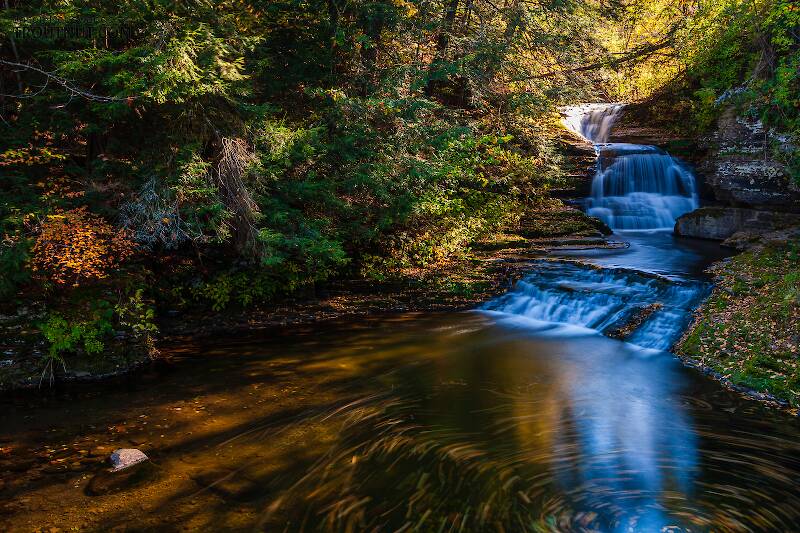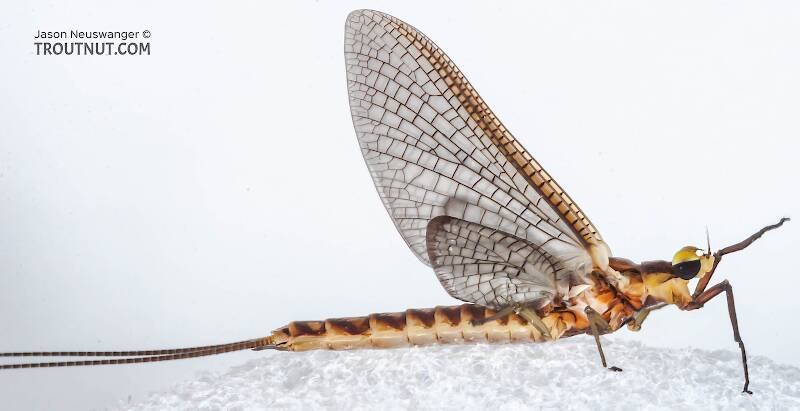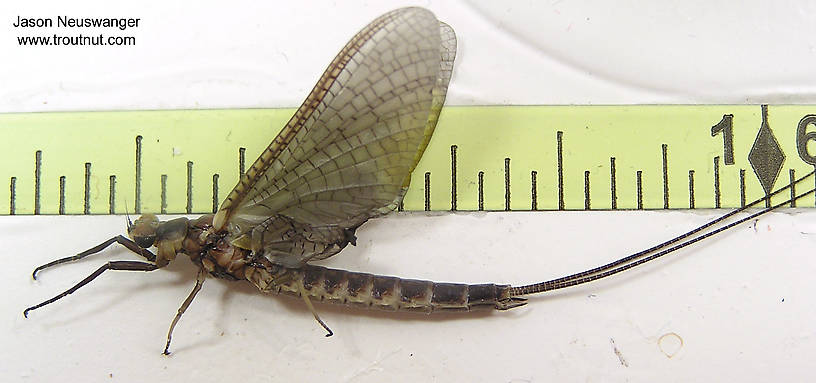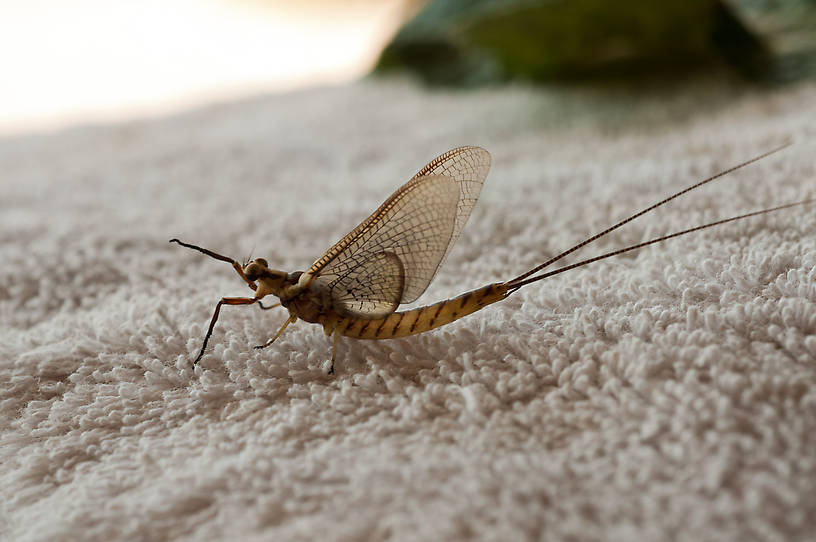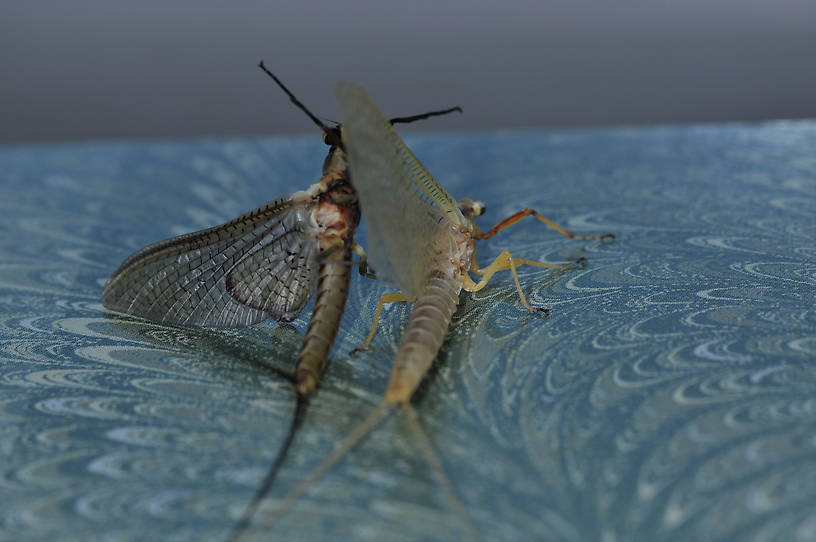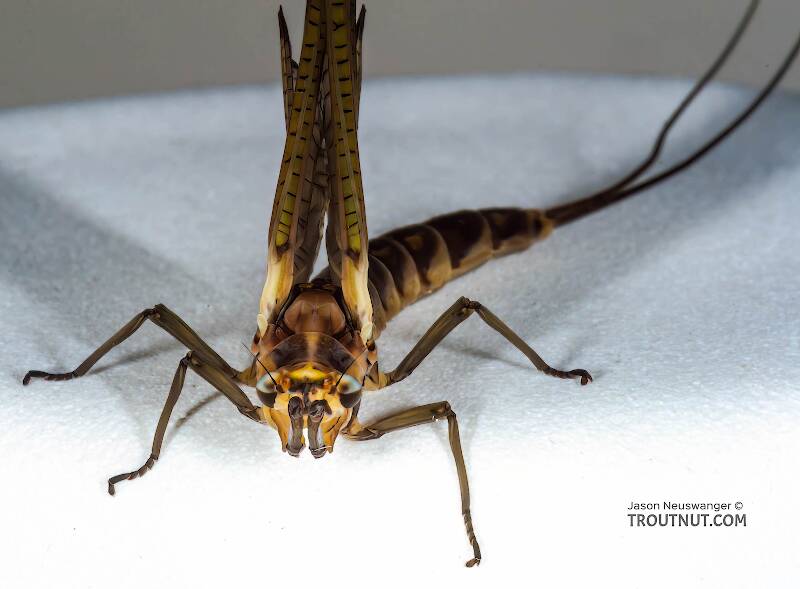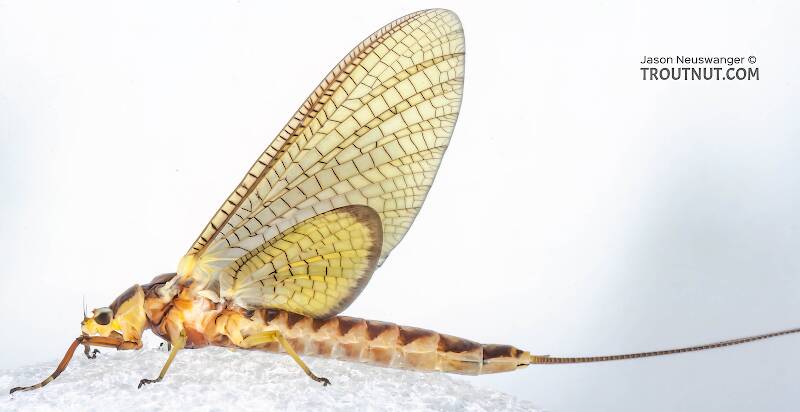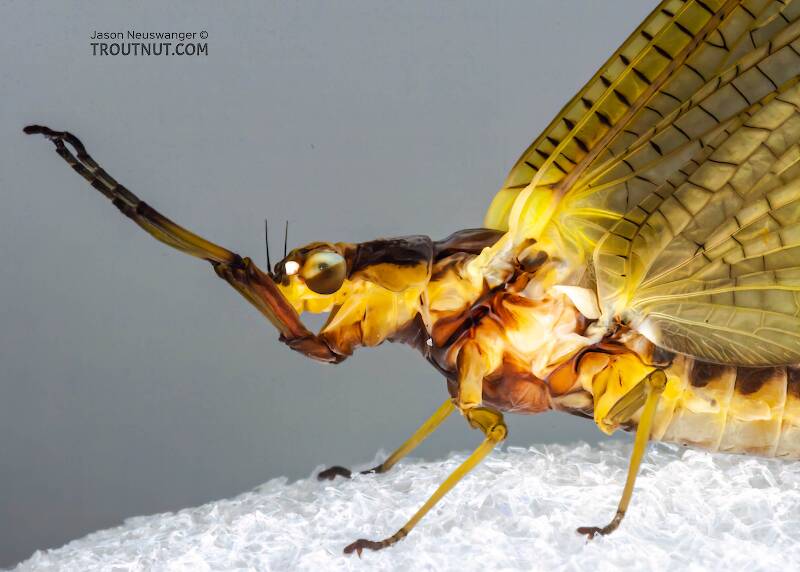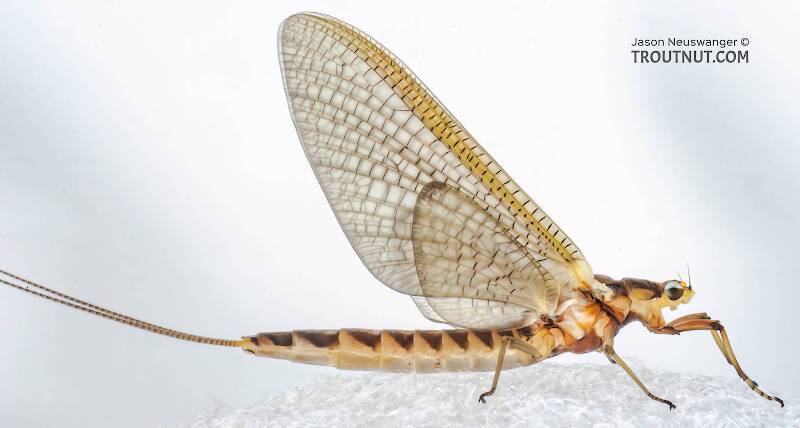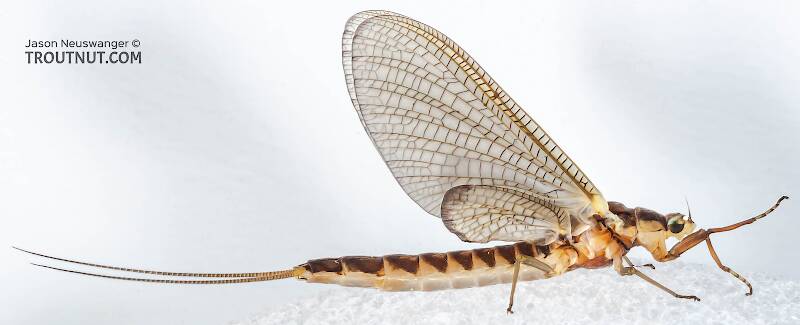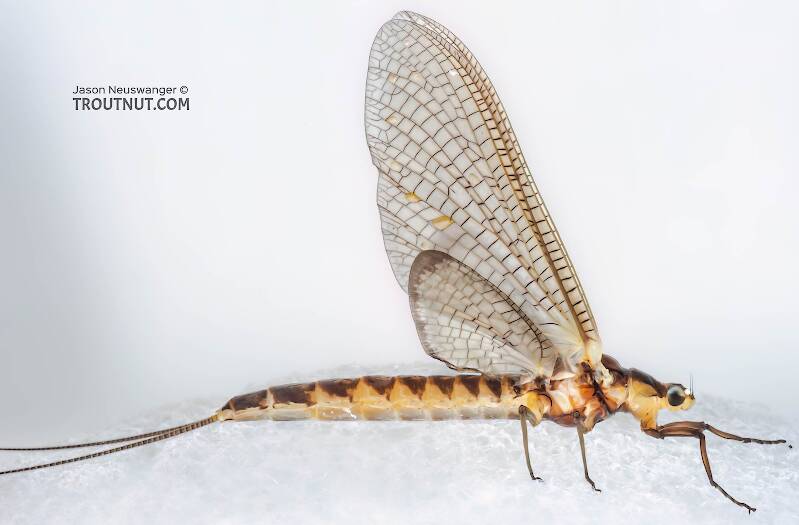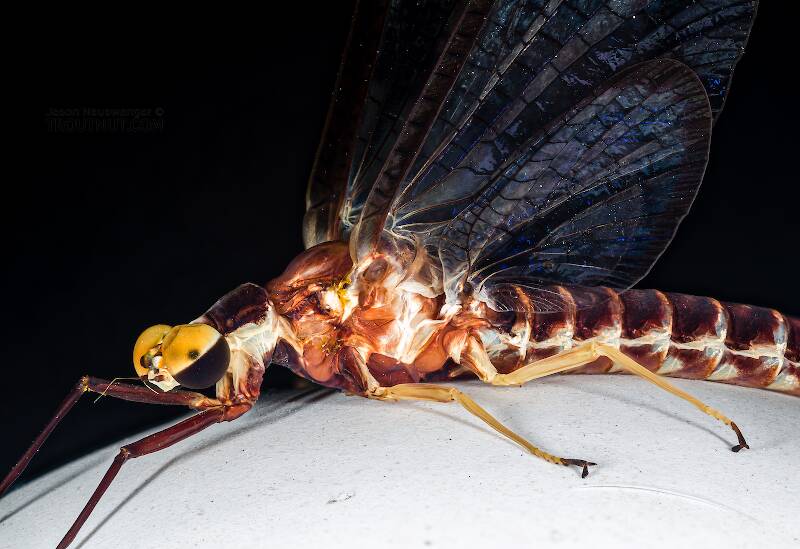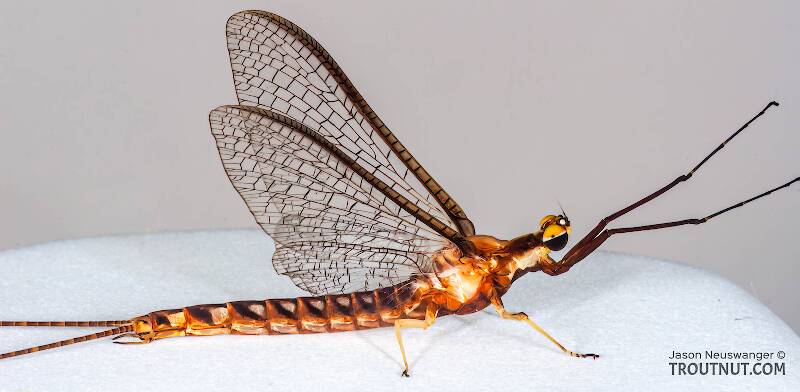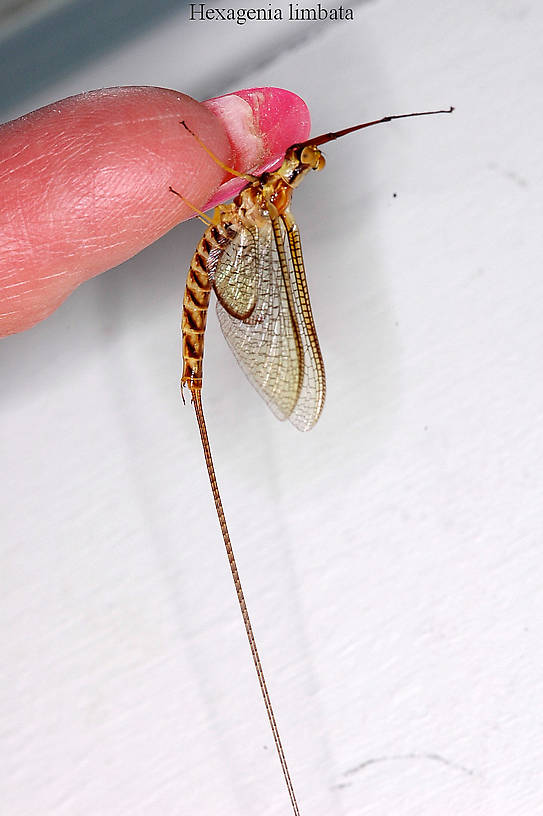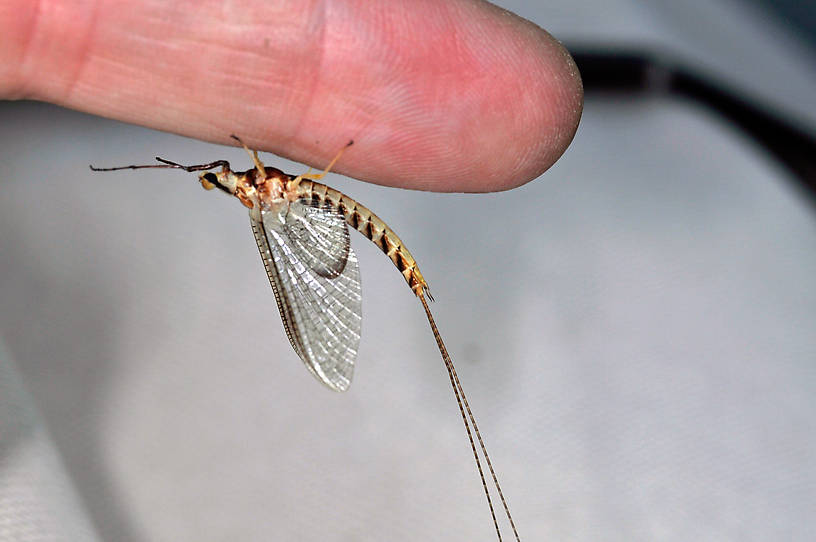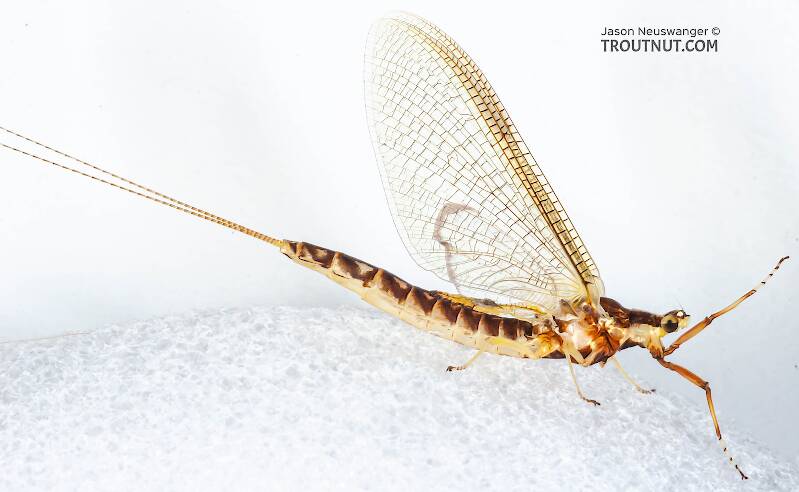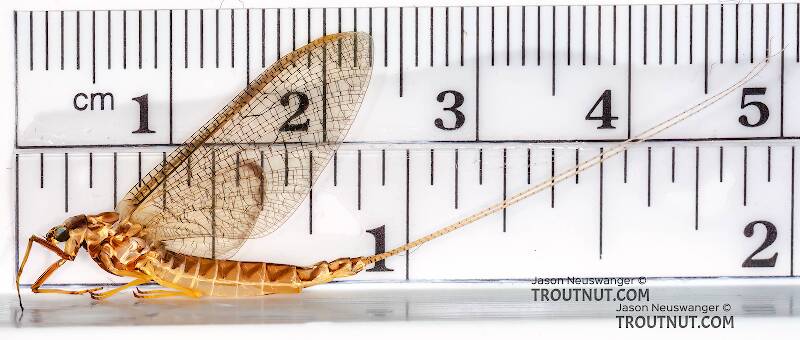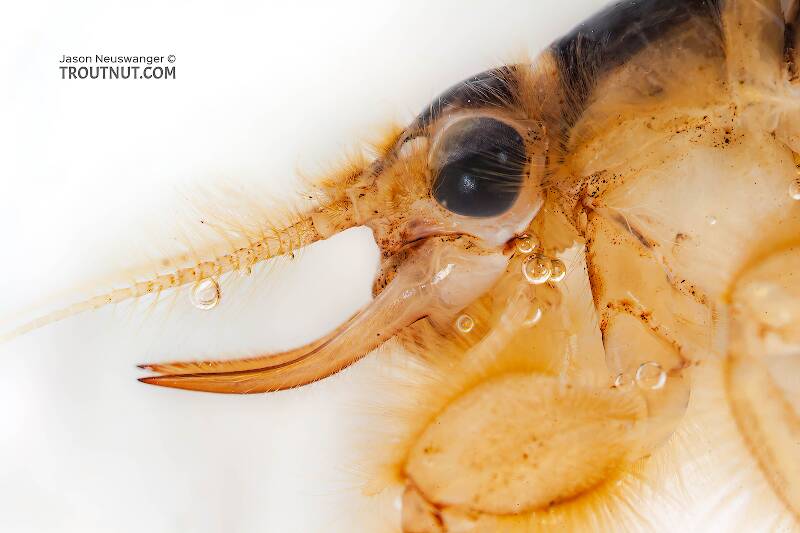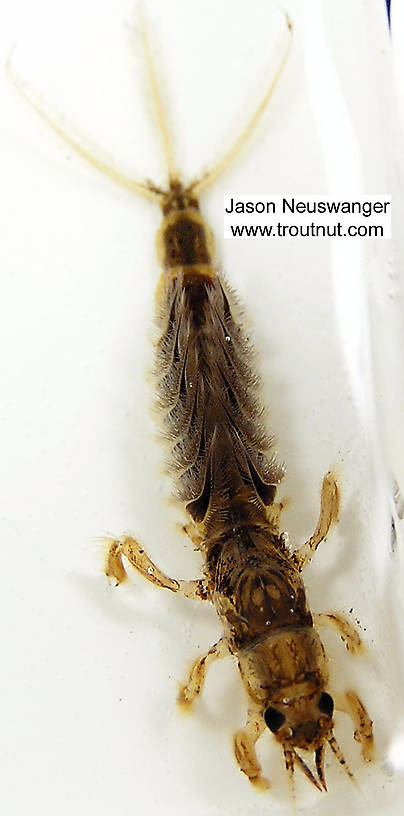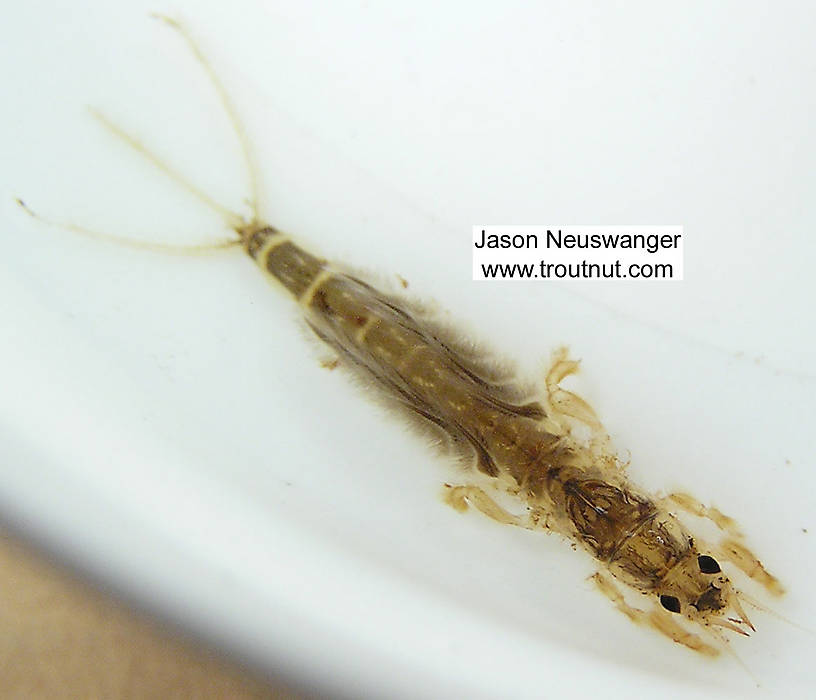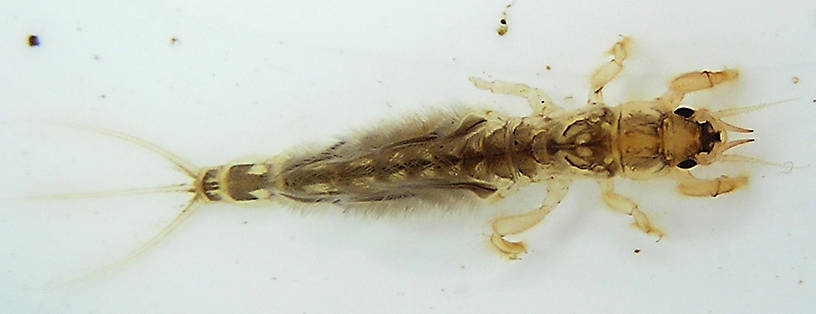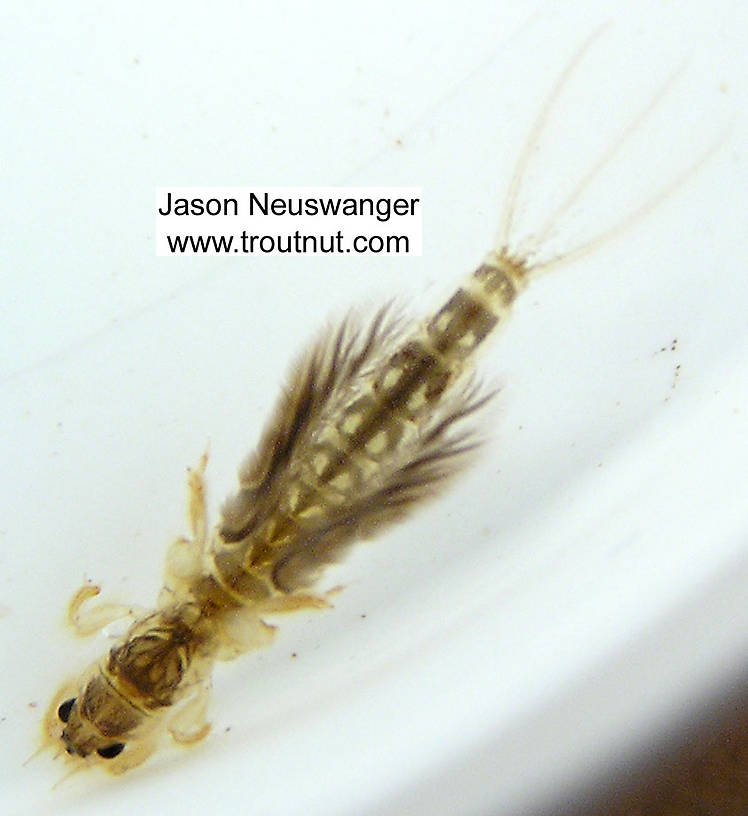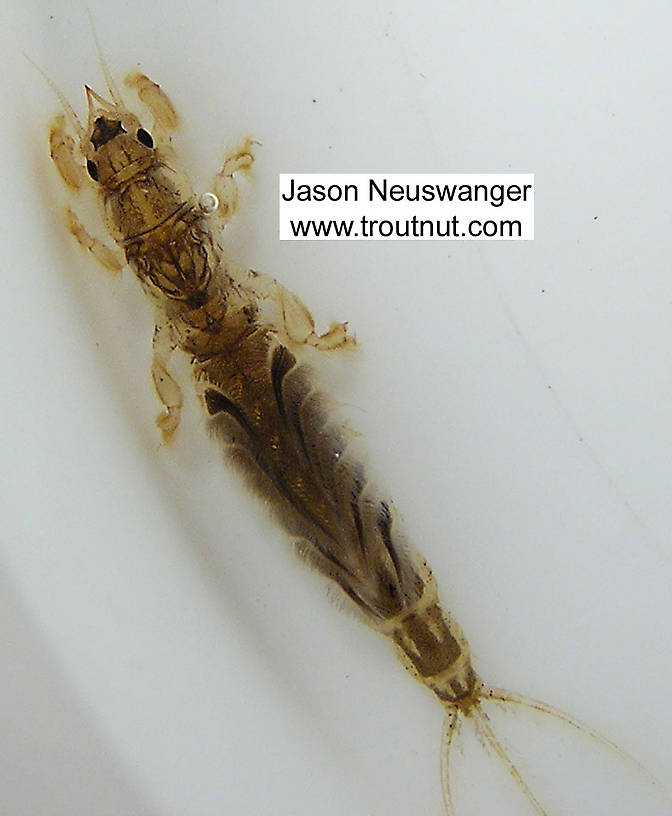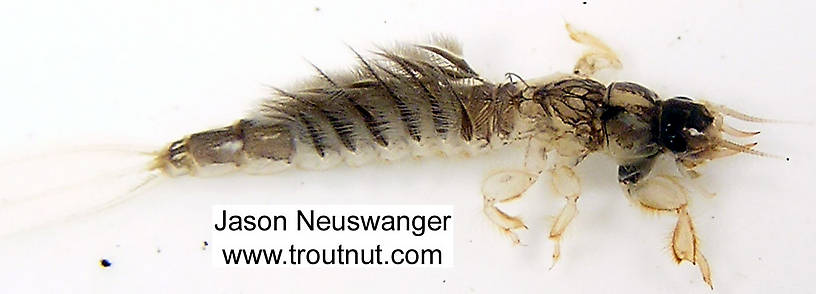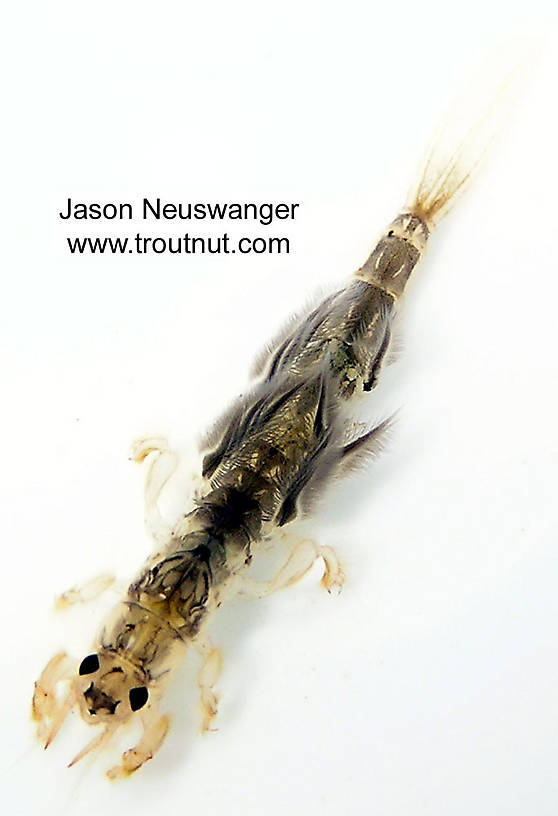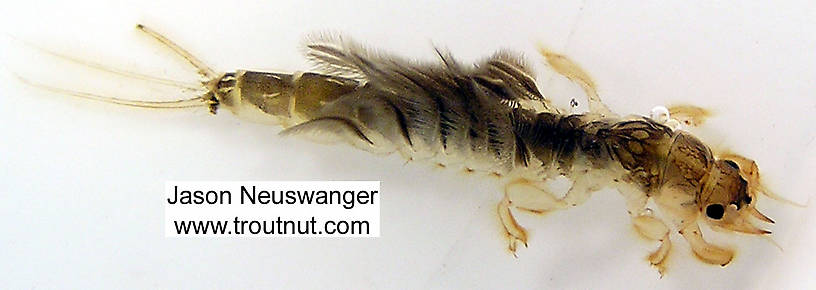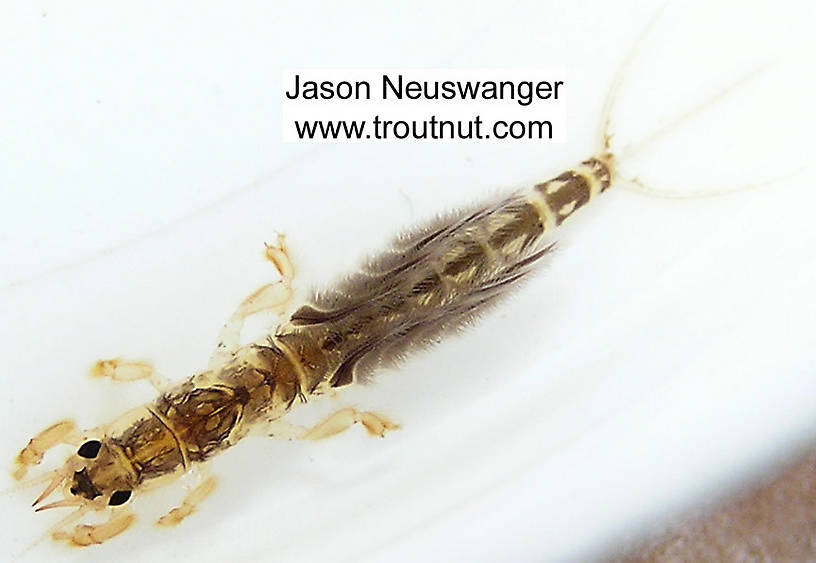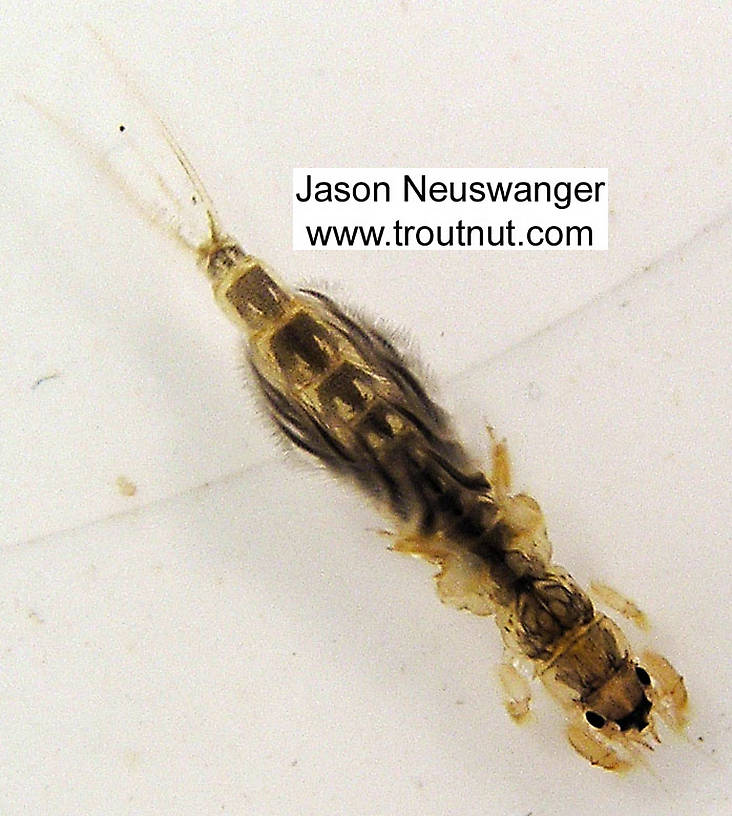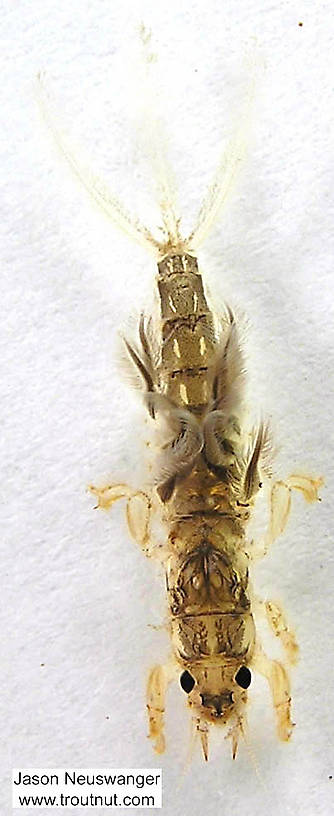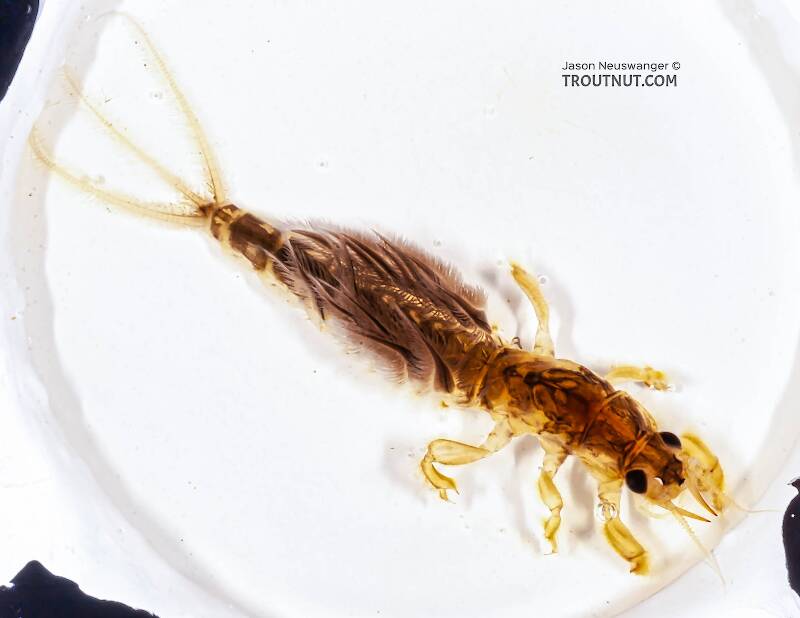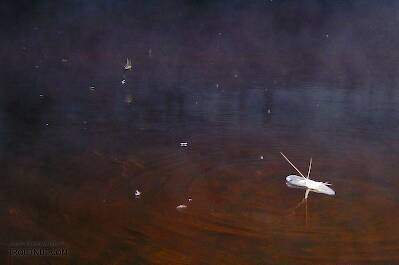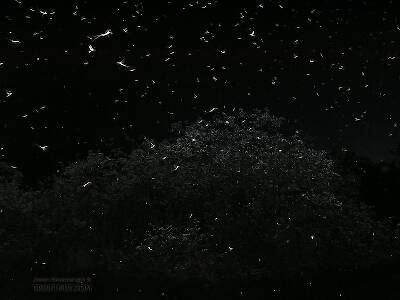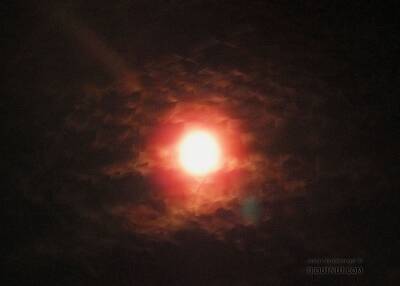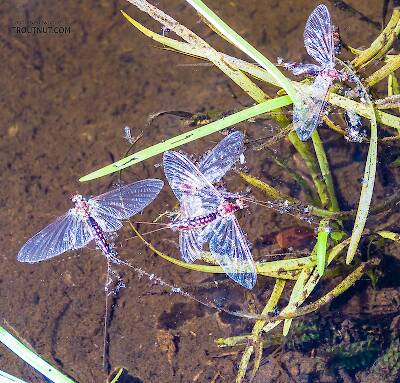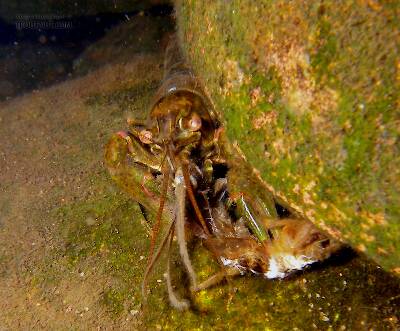
Hex Mayflies
Hexagenia limbata
The famous nocturnal Hex hatch of the Midwest (and a few other lucky locations) stirs to the surface mythically large brown trout that only touch streamers for the rest of the year.


Mayfly Species Hexagenia limbata (Hexes)

This Midwestern legend plays out every year on calm, dark, humid nights in early July. Anglers who only fly fish once a year drive hundreds of miles to play their part in the drama, while the mayflies themselves make the television news by showing up on doppler radar or calling snowplows out of dormancy to remove layers of Hexagenia (or "Hex") duns from the bridges. In the cold trout rivers of Wisconsin and Michigan, huge nocturnal brown trout whose usual menu consists of smaller brown trout become, for a week or so, prime dry fly quarry.
According to the literature, these are the second largest mayflies in the United States, behind the related Litobrancha recurvata flies. However, there are reports of limbata exceeding 40mm in some locales, which would make them the largest.
Where & when
Though it is receiving growing notoriety in the West for providing excellent angling opportunities, Hexagenia limbata won its first fame on the trout streams of Michigan and Wisconsin. It's found in rivers of all sizes and temperatures, including the mighty Mississippi whose vast mud flats put this hatch--literally--on the radar. Stillwaters from tiny spring ponds to Lake Erie can also have good hatches.
The Hex hatch begins in early June in the Driftless Area of Wisconsin and other southerly trout waters. It moves to the northern part of the Upper Midwest through the next several weeks, peaking in the last half of June and first half of July in most of the famous rivers. It lingers into August in the coldest headwaters of this region, as well as in the Northeast, where it is more restricted to stillwaters.
Because of the strict substrate requirements of Hexagenia nymphs, most rivers (even in the heart of their range) do not support good populations. Others have only a few places, a pool here and a run there, with good Hex activity. Nations guard their military secrets less closely than Hex fishermen guard these precious locations. If you wish to look for this hatch away from well-known Hex rivers, you cannot just pick from the map at random. Instead, check with fly shops and follow every whispered rumor. No other hatch creates so much mania on so little water.
Even if you know a river and its trout well during the rest of the year, you might not know it during Hex time. I know at least one river where large trout seem to travel long distances to typically-barren "frog water" specifically to take advantage of the massive Hex population in its silt-bottomed channel. I'm not aware of any scientific studies of this phenomenon, but it would be fascinating to see some telemetry data on the movements of these trout.
In 129 records from GBIF, adults of this species have mostly been collected during June (24%), July (22%), August (22%), September (13%), and May (11%).
In 85 records from GBIF, this species has been collected at elevations ranging from 3 to 11102 ft, with an average (median) of 3035 ft.
Species Range
Hatching behavior
There is disagreement between authors about the manner of emergence. Some say these mayflies take a long time to struggle free from their shucks as emergers. Others say the process is very fast. So the choice to fish an emerger pattern is your gamble, but most people fish this hatch by imitating the duns. Everyone agrees that the duns ride the surface for quite a while before taking off and make a lot of commotion. My observations are mixed: I have seen the nymphs twitching for a while below the surface without breaking through, making commotion that looks like the swirls of feeding minnows, but once they duns start to show they're up and out quickly.
Although the dialy timing of this hatch is predictable, the days when it will occur are not. One night may be so intense the fish can't find your fly among the naturals, and the next night can seem identical but be completely devoid of flies. Hot, humid nights are best, especially when it's very dark. There are old-timers who can feel it in the air when it is coming, but nobody has figured out how to put this sixth sense to words. Ernest Schwiebert described one such fellow in Matching the Hatch:
"According to one local angler I met on the Baldwin, the best nights are "dark as the inside o' yer hat; sorta warm an' muggy." He had three browns over seventeen inches."
Sometimes on cloudy days these duns emerge in the afternoon and the fishing can be incredible. Everybody envies the lucky angler who stumbles onto the rare "Daytime Hex Hatch."
In the West, muggy conditions rarely if ever occur, but wind is common. This affects the fishing approach somewhat. Anglers pray for a soft overcast day that usually brings them on early if it isn't too cold. Nymphs are very effective to fish pre-hatch, especially in still waters. On windy, inclement days, it may be the only way to stir up any action. During normal high pressure conditions the hatching and angling approach are as described above for the Midwest once the hatch commences at last light.
Spinner behavior
Time of day: Shortly after dark.
Habitat: Near where the duns emerged
The large spinners are buoyant and float on the surface for a long time. This can provide good Hex fishing in water far downstream from the original habitat of the nymphs. I once caught two browns, 21 and 24 inches, during a rise to Hex spinners that littered the water from some unseen swarm upstream. There was not a single fly in the air.
Nymph biology
Current speed: Slow streams or stillwater.
Substrate: Silt beds of just the right consistency, soft enough to easily burrow into but strong enough that they don't collapse
Environmental tolerance: They survive in warm water but thrive in cold. They are very durable once they've grown large.
Where the right marl is found, it can support up to 500 nymphs per square foot. The nocturnal nymphs only come out of their burrows to molt, which they do over 30 times in the 2-3 years they take to mature. (By some reports, they also leave their burrows to feed.) Because there are so many nymphs, their sporadic appearances add up to a great year-round food source for the trout where they are most abundant. Caucci and Nastasi do the math in Hatches II and conclude that a trout may see up to 2,000 Hexagenia limbata nymphs per day during non-hatch periods in prime habitat. The real encounter rate is probably much lower, but anything in that ballpark is a major food source. The nymphs are confirmed as a year-round trout food by stomach samples gathered by both the Leonards and Swisher and Richards.
Fred Arbona writes in Mayflies, the Angler, and the Trout that fishing a nymph deep and lifting it up toward the surface occasionally is the most effective way to fish this hatch. The method may work well, but most anglers do not wish to squander the best dry fly opportunity of the year by tossing nymphs into the darkness!
Hexagenia limbata Fly Fishing Tips
People love to share memories of large trout taking dry flies during the Hex hatch with reckless abandon, and sometimes it really is that easy. A few even dismiss the hatch as too easy, not "sporting" enough for their sensibilities, and they stalk these satiated trout by day with a size 22 BWO. Such are the dangers of drinking too much wine.In reality, there are times when Hexagenia limbata poses selectivity challenges to rival any other insect in the country. This is especially true in its final weeks, when the trout are conditioned to expect a full meal and they take their sweet time getting it. Some fish fill up on nymphs and do not rise at all. Others pose classic selectivity problems: they want only dead-drifting or fluttering duns, only half-spent or spent spinners, only males or only females (which are larger). Such large mayflies are easy for trout to scrutinize even in the dark, and sloppy imitations are often ignored.
Because much of this action takes place in pitch darkness, there is a whole new set of challenges to be met and skills to be learned. Ernest Schwiebert describes the subtle touch:
"Night fishing can get into your blood, and your senses become amazingly attuned to it. You will find yourself casting accurately to rises you only hear. The slightest disturbance near your fly puts the reflex on edge; you must strike at these rises, for it is easy to assume your fly to be elsewhere and never strike at a good fish."
Carl Richards offers another good tip in a short essay in Mayflies: An Angler's Study of Trout Water Ephemeroptera :
The trick for night fishing the Hex hatch is to get as close as possible. Experienced anglers know the water, wade into position, and cast a very short line. They fish strictly to sound and strike on the splash.
Fishing "strictly to sound" might be a slight exaggeration, but sound is certainly crucial for locating and judging the size of fish. I let sound guide my eyes, then focus intently on the source for even the faintest glint of starlight off a ripple in the surface that might signify a rise.
Some of the best Hex anglers learn where the biggest trout live and stake out their positions before dusk. They wait like patient hunters, rather than fishermen, for their trophy to rise. They know its schedule. They study its feeding rhythm. They match their wits against its instincts night after night until they hook it, and then the game is won whether they bring the fish to hand or not.
Physical description
Most physical descriptions on Troutnut are direct or slightly edited quotes from the original scientific sources describing or updating the species, although there may be errors in copying them to this website. Such descriptions aren't always definitive, because species often turn out to be more variable than the original describers observed. In some cases, only a single specimen was described! However, they are useful starting points.
Male Spinner
Wing length: 10.5–20 mm
Body length 19 mm, wing length 18.5 mm (as originally described)
A pale yellow species; abdominal tergites with distinct yellow areas and brown markings; outer margin of hind wing dark-bordered.
Thorax reddish brown; blackish lateral stripes on pronotum. Legs yellow; fore femur and tibia blackish. Wings hyaline, with no conspicuous spots; anterior margin of fore wing not much darkened; outer margin of hind wing brown. Abdomen yellow marked with brown; mid-dorsal line of tergites widely dark; lateral stripes begin at antero-lateral angles and extend backward to meet median stripe at posterior margin. Tail joints pale yellowish basally, dark brown distally. Genitalia of the limbata type.
Described as H. affiliata
Body length 19-22 mm, wing length 18-20 mm
Abdominal tergites largely blackish brown, pale yellow lateral triangles surrounded by dark color; ventral triangles do not attain anterior margin; penes of limbata type.
Frontal portion of head yellowish white; antennae pale brown; vertex purplish. Upper portion of eyes with a greenish tinge; separated by a space about equal to one diameter of eye. Pronotum purplish brown, the lateral and median areas paler. Mesothorax and metathorax red-brown; scutellum marked with purplish; an oblique dark red streak on pleura anterior to middle leg; posterior portion of prosternum purplish. Fore leg reddish brown; extreme basal portion of middle tarsal joints may be slightly paler. Coxae and trochanters of middle and hind legs pale reddish; femora, tibiae and tarsi yellow; claws, distal tarsal joints and tarsal joinings purplish brown. Wings hyaline; costal margin of fore wing tinged with reddish brown, paler at apex. Veins dark purplish brown; a few cross veins in and behind costal margin of fore wing and in disc of hind wing narrowly margined; in the latter, a few small dark spots. No dark outer margin on hind wing.
Abdominal tergites largely blackish brown; yellow postero-lateral triangles and somewhat irregular submedian yellow areas, one on each side of each tergite, not based on anterior margin as in Hexagenia rigida, but wholly surrounded by dark color. Posterior margins of middle tergites may be very narrowly paler, much less evident than in rigida. Sternites yellowish white; mid-ventral line purplish black over ganglionic areas. A semi-circular reddish brown patch based on the posterior margin of each basal and middle sternite extends forward only as far as the middle of the segment, not attaining the anterior margin; on the apical sternites these patches are triangular and extend somewhat further forward. Reddish oblique submedian streaks from the anterior margin are more or less evident. Tails broadly and irregularly banded with yellow and brown. Genitalia largely dark red-brown; penes of the H. limbata type; distal forceps joint very small, third one quite well developed. The abdominal pattern and lack of dark outer margin on the hind wing, distinguish these species from others having the same type of genitalia.
Described as H. carolina
Body length 20.5 - 24 mm, wing length 14.5-17 mm
A large pale species; abdominal stripes rose or lavender; a few small spots in hind wing only.
Eye golden brown above; head creamy white; purplish spot near base of eye on each side, another near carina. Pronotum creamy white, lateral stripes purplish. Remainder of thoracic notum and pleura yellowish; brownish markings. Median anterior portion of mesosternum and ventral aspect of middle coxa purplish; sternum elsewhere creamy white. Fore femur light rose; tibia deeper rose; basal tarsal joint and all but extreme base of distal joint, claws and tips of middle tarsal joints, purplish; remainder of tarsus creamy. Fore leg rather short, about half as long as body. Middle and hind legs creamy white; tarsal joinings narrowly purplish, also claws and apical half of distal joint. Wings hyaline; costal border of fore wing yellowish brown; costa, subcosta, and radius golden brown, other longitudinal veins and cross veins purplish brown except in anal region. In hind wing, subcosta and radius purplish browns, other longitudinal veins yellowish white; cross veins purplish black, a few in disc faintly margined to form one or two very small dark spots, not conspicuous. Outer margin not darkened.
Abdomen creamy white on 1-7, 8-10 yellowish; posterior margin of each creamy white. Faint grey median dorsal streak on tergites 1-6; on 7-10 this median streak is wider and darker grey. Lateral oblique stripes grey-rose to lavender; on tergite 1, occupy most of lateral space, and joined at anterior margin to median line; on 2-6, similar but narrower lines connect stripe to median line anteriorly, on 6 joined also on posterior margin; 7-9, marks appear as lateral arm from median stripe. Ganglionic areas of sternites 6-10 purplish brown. Faint yellowish median streak on 8 and 9, and a faint triangle on 7, otherwise unmarked. Genitalia of the carolina type (now a synonym of Hexagenia limbata) (see fig. 84). Second joint of forceps rather swollen distally; two distal joints of moderate size; penes and forceps marked with purplish. Tails reddish brown; each joint darker apically, joinings very dark, basal end pale whitish; tails creamy white at extreme tips.
Described as H. elegans
Body length 12-17 mm, wing length 10.5-12 mm
A rather small slender species; abdomen whitish, with purplish red lateral stripes; triangles on middle and apical sternites do not reach beyond middle; dark spots in both wings; hind wing dark on outer margin.
Eye golden tan above. Vertex creamy, flesh-pink near posterior margin. Prothorax flesh-colored, lateral stripes mahogany-red. Remainder of thoracic notum creamy white; pleura similar, with few reddish markings. Dark purple spot posteriorly on prosternum; mesosternum anteriorly, and metasternum wholly dark red-brown; remainder of mesosternum paler shade of same color. Fore femur and tibia deep rose-red; basal and distal joints of tarsus, and distal half of middle joints, purplish brown; basal half of middle joints whitish. Fore leg rather short, little more than half as long as body. Middle and hind legs white; claws, distal tarsal joint except at base, apical margin of third joint, and joinings of others purplish brown. Wings very iridescent; costal border of fore wing dark brown; longitudinal veins of fore wing, of costal margin of hind wing, and all cross veins, purplish black. Many veins in both wings margined, forming many dark spots in each wing. Outer margin of hind wing prominently purplish brown.
Abdomen whitish; sternites 1-6 flushed with pink; segments 7-10 distinctly yellowish. Faint grey median line on tergites 1-6, becoming broader and reddish brown on 7-10. Lateral stripes on tergites vary from lavender to purplish rose; connected on posterior margin to median stripe. Ventral triangles indicated by outer dark stripes only, except on apical sternites, where triangle is fully colored; these do not reach beyond middle of each sternite except on basal segments, where they may almost attain anterior margin. Genitalia of carolina type (now a synonym of Hexagenia limbata); two distal joints extremely small. A rose-colored spot on each side of purplish brown forceps base; forceps and penes with purplish brown markings. Tails dark brown on apical portion of each joint, darker at joining; basal half of each joint greyish white. In some joints the joint is wholly dark except for narrow basal ring.
Described as H. marilandica
Body length 18-19 mm, wing length 15-16 mm
A rather large species; abdomen whitish, dorsum tinged with pinkish, lateral stripes purplish rose, no mid-dorsal stripe on middle tergites.
Head greyish white; eye slate grey above; space between eyes equal to one diameter of eye. Pronotum tinged with yellowish; lateral stripes rather broad, purplish brown. Mesonotum creamy white, bordered with light brown; metanotum creamy yellow, marked with lavender. Pleura whitish. Prosternum white, two purple streaks between legs. Anterior portion of mesosternum dark purplish rose; posteriorly light, tan with lateral lavender marks. Metasternum white, bordered with purplish. Fore coxa and trochanter purplish; femur and tibia rose-red, joinings darker. Basal and distal tarsal joints, distal third of middle joints, and claws, purplish brown. Middle and hind legs creamy white; coxa of middle leg purplish red anteriorly; claws, apical two-thirds of distal tarsal joints, and joinings of fourth and fifth joints, purplish brown. Costal margin of fore wing brown, darker in distal half but paler again at apex. Longitudinal veins brownish rose; cross veins purplish black; a few cross veins in each wing very narrowly margined, may form a few very small dark spots in disc of hind wing. Hind wing not darker on outer margin.
Abdomen creamy white with pinkish flush; 8-10 yellowish. Greyish mid-dorsal stripe on tergites 6-10, 1-6 with only a very fine grey line. Lateral stripes seem to form a continuous zigzag pattern on each side; purplish rose in color. Posterior margins of tergites 7-9 widely dark. A purplish mark on ganglionic area of each sternite; on sternites 8 and 9, greyish rose triangles extend to about the middle of the segment. On basal and middle sternites, no complete triangles, but short oblique streaks on posterior margin at each side mark the outer boundaries; on 6 and 7, short grey lines extend from these to mid-line at center. Basal joints of tails yellow in basal half, dark red-brown distally. In remainder of tail, each joint dark red-brown, darker distally, with a narrow yellow basal ring. Genitalia of the H. carolina type (now a synonym of Hexagenia limbata); basal forceps joint relatively long, the two distal joints very small and poorly developed. Forceps base, penes and forceps amber, marked with purplish brown.
Described as H. mingo
Body length 18-19 mm, wing length 15-16 mm
Abdomen whitish or pinkish, lateral stripes reddish brown; mid-dorsal dark stripe on all tergites; ventral triangles reach anterior margin.
Head light tan; creamy yellow markings on vertex. Eye creamy to light tan above; rather large, separated by space less than diameter of eye. Pronotum light tan, lateral stripes wide, dark red-brown. Mesonotum light tan with dark brown markings; metanotum light brown. Pleura whitish, washed with light brown on mesothorax. Prosternum pale anteriorly, dark red-brown posteriorly; center of mesosternum light red-brown, margins dark brown; metasternum dark brown. Fore coxa and trochanter brown; femur and tibia mahogany brown, joinings darker; in holotype, tarsus entirely dull brown, in other specimens the basal part of the middle joints often paler. Middle and hind legs canary yellow; distal tarsal joints, claws and tarsal joinings purplish brown. Costal margin of fore wing reddish brown; apex and base of costal space light tan. Longitudinal and cross veins of both wings dark purplish; several cross veins in each wing somewhat margined, tending to form a few small spots in hind wing. Outer margin of hind wing narrowly dark in some specimens, not in others.
Abdomen whitish or with a pinkish flush; wide dark mid-dorsal stripe on all tergites, becoming wider at posterior margins. Tergites 1 and 2 largely purplish brown. Lateral stripes arise at antero-lateral margins and extend to median stripes at posterior margin; these are quite wide and occupy most of each side of tergite. Reddish brown ventral triangles extend forward to the anterior margin on sternites 1-8; ganglionic area of each somewhat darker in color. Two small clear round spots near center of each sternite, one on each side. Basal joints of tails yellowish brown in basal half, somewhat darker brown distally; nearer the tip, joints wholly brown except for narrow yellow basal ring. Genitalia intermediate between Hexagenia limbata and carolina(now a synonym of Hexagenia limbata) types; forceps base yellow, two purplish brown spots at anterior margin; forceps and penes yellow marked with purplish brown.
Described as H. munda
Body length 18 mm, wing length 14 mm
Abdomen light yellowish, tergites with pitch-black U-shaped markings; triangles on sternites do not reach beyond middle of each segment; wings tinged with very light brownish grey, no large dark spots in wings.
Thoracic notum light raw-umber; a broad blackish brown stripe on each side of pronotum, extending backward on mesonotum beyond wing roots. Prothoracic pleura yellowish. Metanotum piceous in part. Anterior portion of mesosternum, and a spot at joining of mesosternum and metasternum, piceous. Fore coxa yellowish; anterior portion of middle coxa piceous. Fore legs from trochanter to basal joint of tarsus pitch-brown, trochanter and femur at base paler on inner side; tarsal joints 2—4 “pitch-brown distally, but warm sepia grey in their proximal halves.” Middle and hind legs pale yellowish; distal tarsal joint, apical margin of fourth joint, and claws, deep blackish brown. “Wings transparent, almost uniformly tinted with extremely light bistre grey; the marginal and submarginal areas of the fore wing distinctly bistre-grey; the terminal margin of the hind wing very narrowly tinged with light greyish; longitudinal neuration bronzy raw-umber brown, becoming light yellowish at the wing roots, and in part appearing black in certain lights; cross veinlets black, bordered narrowly with blackish in the same parts of the wing as Hexagenia bilineata” (Eaton).
"Abdomen very light yellow ochraceous, marked with pitch-black above, and light burnt umber beneath” (Eaton). Tergites 1-7 with broad lateral stripes from the antero-lateral angles, “rounded off posteriorly just before the distal border of the segment’’; these are joined together on posterior and anterior margins by narrow bands of same color as stripes, so that markings appear like “the letter U closed by a line across the top, with arms of equal thickness” (Eaton). Median area of 1-6 pale except for a narrow greyish line; tergite 7 with a broad dark median stripe. On tergites 8 and 9 the dark median line is present as on 7, but lateral stripes do not reach anterior margin. Sternites 1-7 with markings arising from posterior margins, “‘semielliptical in the hinder, but in the form of a small segment of a circle in other segments’’; these do not extend beyond the middle of each sternite. Sternites 8-10 “bright light brown ochreous.” A black mid-ventral streak at anterior margin of each sternite. Tails “intense bistre-brown, lighter close to their insertion, their joinings very light”; some joints lighter at anterior margins.
Described as H. occulta
Body length 17-18 mm, wing length 18-19 mm
A reddish brown species, extremely variable as to amount of reddish suffusion; outer margin of hind wing usually dark-bordered; ventral triangles attain anterior margin.
Frontal portion of head yellowish; vertex suffused with yellow; remainder of head dark brown. Eyes yellowish brown above; separated by space less than one eye diameter; relatively smaller than in H. viridescens (now a synonym of Hexagenia limbata). Pronotum dark red-brown; median line narrowly pale, lateral margins yellow; a large pale area above fore coxa. Mesothorax and metathorax reddish brown, depth of color variable; mesonotum reddish yellow, scutellum and region anterior to it yellowish. A large pale area on pleura before hind wing root; a smaller pale area below root of fore wing. Sternum dark purplish brown. Fore leg dark red-brown; femur and tibia brighter than tarsus; middle tarsal joints sometimes slightly paler at bases. Fore leg long, only slightly shorter than body. Middle and hind legs yellow with greenish tinge; claws, distal tarsal joint except at base, and distal margins of other joints, light purplish brown. Wings hyaline; costal margin tinged with reddish to purplish brown, deepest in stigmatic area, palest in basal costal space. Veins purplish black; several to many cross veins on costal margins and in discs of both wings margined, those in disc of hind wing forming small dark spots. Outer margin of hind wing usually with a well-defined purplish brown border.
Abdominal tergites largely reddish brown, amount of reddish suffusion very variable. Pleural fold usually yellow in whole or in part; yellow postero-lateral triangles and yellowish submedian streaks or narrow triangles are typically present; the former may be much reduced; the latter are usually surrounded by dark color. Large red-brown triangles occupy most of each sternite, their apices attaining the anterior margin; ganglionic areas purplish black; pale oblique submedian streaks at anterior margin, and two pale central dots, in each sternite. Lateral dark streaks may be present, often connected to central triangles; remaining areas yellowish. Tail joints yellow basally, deep brown apically; joinings appear as yellow rings. Genitalia yellowish red; second joint of forceps whitish basally; penes of limbata type (see fig. 84). This species differs from H. limbata in the reddish suffusion of the yellow areas; dark specimens may be readily confused with H. viridescens (now a synonym of Hexagenia limbata), but the eyes of the latter are relatively larger and darker above.
Described as H. pallens
Body length 19 mm, wing length 16 mm
A pale whitish species, without prominent dark markings; longitudinal veins pale; hind wing not dark-margined; penes of limbata type.
Head purplish red, frontal margin pale; bases of antennae deep rose-colored. Eyes large, separated by a space less than one eye diameter; in alcoholic specimen, purplish black above and below. Pronotum yellowish white, lateral stripes pale purplish rose. Mesothorax and metathorax flesh-colored, with distinct yellowish tinge. Pale purplish red oblique streak anterior to wing roots, and on pleura anterior to each middle and hind leg; a purplish spot at joining of prosternum and mesosternum. Fore coxa yellowish with pinkish tinge; trochanter pale rose; femur and tibia deep purplish red; basal and distal joints of tarsus, and claws, deep purplish; distal portion of middle joints greyish lavender, joinings purplish, basal portions greyish white. Middle and hind legs pale yellowish; claws, distal tarsal joints and joinings of 2nd and 3rd joints pale brown with rose tinge. Wings hyaline, pale. Costal margin of fore wing faintly yellowish; costa, subcosta and radius deep yellowish amber, subcosta tinged with brown. Other longitudinal veins of fore wing, and subcosta of hind wing, pale yellowish; those of hind wing behind subcosta white. Cross veins deep blackish purple; in costal margin of fore wing rather coarse, margined with purplish; elsewhere fine, rather inconspicuous, only a few in disc of each wing very narrowly margined, not forming dark spots. Outer margin of hind wing not dark-bordered.
Abdomen semi-hyaline, pale yellowish white, the two apical segments opaque, more yellow. Faint semi-hyaline purplish shading laterally on basal and middle tergites; a faint brownish median streak on 9; no other dorsal markings. On apical sternites, a very small pale purplish blotch in each antero-lateral angle; ganglionic areas purplish on all sternites; median area of 1-3 faintly shaded with purplish, the posterior margin of 1 somewhat darker; no other markings. Tails reminiscent of H. venusta (now a synonym of Hexagenia limbata); in middle area, groups of two or three joints all rose-colored except for narrow basal pale ring on each; between these dark joints, a pale joint, rose-colored at apex only. In basal and apical areas, joints rather uniformly rose-colored apically and pale at base. Genitalia pale yellowish white; tips of forceps purplish, the distal joints rather short, second joint rather long; penes of the limbata type.
Described as H. rosacea
Body length 20 mm, wing length 17 mm
Abdomen whitish; lateral stripes deep rose-colored; median dark stripe on all tergites; hind wing not dark on outer margin, and with no dark spots.
Head greyish white; carina rose-colored distally; eye creamy above, quite large; space between eyes less than one diameter of eye. Pronotum greyish white, lateral stripes purplish red. Mesonotum whitish with creamy markings and rose-brown border; metanotum yellow with rose markings. Pleura white, with lateral rose stripes to base of middle legs. Prosternum white, a faint lavender streak posteriorly; mesosternum deep rose, posterior margin white; metasternum purplish rose. Venter of fore coxa in distal half, trochanter and femur rose-colored; tibia deep rose; basal and distal tarsal joints, and distal third of middle joints, deep purplish rose. Middle and hind legs white; tarsal joinings narrowly purplish, as are claws and distal two-thirds of fifth joint. Wings very iridescent; costal margin of fore wing light brown in basal half, dark brown distally. Costa, subcosta and radius golden brown, other longitudinal veins dark purple. Cross veins purplish black; no dark spots in either wing. Hind wing not darker on outer margin.
Abdomen white on segments 1-6; 7-10 yellow. A rather wide median dorsal stripe on all tergites; greyish brown on 1-5, reddish brown apically; progressively wider from 7 to 9. Tergites 1 and 2 dull rose grey except for white mark near pleural fold, one on each side near anterior margin, and pinkish crescent posteriorly at median line. Tergites 2-7 with deep rose oblique lateral stripes from antero-lateral angles to posterior margin, joining median stripe; on anterior margin a narrow streak extends halfway to median stripe. Posterior margins of 4-9 deep rose-colored. A dark rose streak marks ganglionic area on each sternite; triangles deep rose, the middle portion of each pale, so as to appear on middle sternites as two small lateral triangles; these do not attain the anterior margin. Posterior margins of sternites 2-10 deep rose-colored. Basal joints of tails deep rose distally, yellow at base, reddish black at joinings; in middle area, joints dark brown in distal two-thirds, yellow at base, joinings darker; in distal portion, joints dark brown except for narrow light ring at base. Genitalia of the carolina type (now a synonym of Hexagenia limbata); golden yellow, marked with reddish brown.
Described as H. venusta
Body length 15-18 mm, wing length 15 mm
A yellowish species marked with purple-madder; longitudinal veins yellow, except on costal border; no large dark spots in veins.
Head yellow; second basal joint of antenna, and markings at base of and between ocelli, purplish brown. Thorax yellow; purplish red stripe on each side of pronotum, extending back on mesonotum to wing roots; an oblique purplish streak on pleura anterior to middle leg. Sternum largely deep purplish red, including median posterior area of prosternum; posterior portion of mesosternum paler than other portions, dark and widest posteriorly on metasternum. Fore legs madder-brown or purple-brown, tibia brighter than femur, tarsus dull; tarsal joints 1 and 5 wholly dark, others pale whitish in basal portion. Fore leg rather short, somewhat more than half as long as body. Middle and hind legs yellowish white; claws, all but extreme base of distal tarsal joint, and tip of third tarsal joint purplish brown. Wings hyaline, tinted very faintly with pale yellowish; costo-apical region and to a lesser extent the whole costal margin tinged distinctly with raw-umber. Costa, subcosta and radius of fore wing reddish brown (Eaton says, dark pitch-brown); other longitudinal veins in both wings yellowish. Cross veins blackish; those in costal border margined with dark brown, most extensively in stigmatic area; a few in disc of each wing very narrowly margined, but no dark spots in either wing. Outer margin of hind wing purplish or blackish brown, often in alternate wide and narrow areas.
Abdomen whitish yellow, semi-hyaline, on segments 2-7; 8-10 opaque, somewhat, deeper yellow. Lateral somewhat triangular purplish red patches are present, one on each side, on all tergites except the last two, “the triangles truncate posteriorly, and in segments 1-4 reaching from base to joining, but in the others not starting from the base of the segment” (Eaton). A broad median streak on tergites 8 and 9, not reaching the anterior margin, on 8; rather purplish grey. A purplish red mid-ventral streak on all sternites, connected with dark metathoracic sternum; widest on basal sternites, becoming & mere line apically. Ganglionic area of each sternite blackish. Within the purplish band, except on sternites 8 and 9, a whitish dot on each side of median line, near center of segment; a similar pair of white dots on metathoracic sternum. In antero-lateral angle of each sternite, a small purplish triangle. Tails pale yellow, irregularly marked with purple-madder, sometimes at joinings, sometimes at apical margins of joints, at intervals an entire joint being dark. In female, tails wholly light yellowish, unmarked. Genitalia of the limbata type; pale yellow, marked with purple.
Described as H. viridescens
Body length 19-20 mm, wing length 18 mm
A large dark species; submedian pale markings on tergites reduced to narrow streaks; outer margin of hind wing dark-bordered; ventral triangles attain anterior margin.
Frontal portion of head yellowish; antennae, vertex and occiput purplish brown. Eyes deep brown above; large, separated by space less than one eye diameter. Pronotum deep purplish brown; lateral areas behind and above fore coxa narrowly yellowish. Mesothorax and metathorax purplish brown with a distinct reddish tinge; sternum and an oblique streak on pleura anterior to middle leg and below wing roots somewhat darker. Fore leg dark red-brown; middle tarsal joints very slightly paler basally. Fore leg long, almost equal to body in length. Middle and hind legs yellowish with a distinct reddish tinge, most evident at apices of femora; claws, distal tarsal joint and distal third of other joints, blackish brown. Wings hyaline; costal margin of fore wing reddish to olive brown; all veins deep purplish brown. A few margined cross veins in disc of hind wing tend to form small dark spots. Outer margin of hind wing with a rather wide purplish brown border.
Abdominal tergites largely deep purplish or blackish brown; posterior margins, small postero-lateral triangles and narrow submedian dashes on each tergite pale yellowish. Pleural fold yellowish white. Sternites paler reddish brown, each with a dark red-brown median triangle, the apex of which attains the anterior margin. Mid-ventral line purplish black on apical sternites, and at ganglionic areas on middle ones. Tails deep red-brown, each joint with a narrow yellowish ring at base. Genitalia deep purplish brown; penes of the limbata type. The very limited pale dorsal markings, dark-margined hind wing and ventral triangles which attain anterior margin distinguish this species from others with similar genitalia except H. occulta (now a synonym of Hexagenia limbata); dark specimens of the latter species may have very similar maculation. The larger eyes, dark above, and slightly larger body size of H. viridescens (now a synonym of Hexagenia limbata) are means of separation.
Described as H. weewa
Body length 22-24 mm, wing length 17-19 mm
A large species; abdominal stripes purplish brown; outer margin of hind wing dark, several dark spots in disc.
Head yellowish white; eyes purplish grey above, large, separated by space less than one diameter of eye. Pronotum light tan; lateral stripes purplish brown, extensions to wing base brown. Mesonotum creamy white bordered with brown. Metanotum yellowish. Pleura yellowish, shaded with brown on mesothorax. Posterior portion of prosternum, anterior of mesosternum and entire metasternum dark purplish brown; posterior of mesosternum lighter shade of same color. Ventral portion of fore coxa, trochanter, femur, tibia and basal tarsal joint mahogany brown; basal half of middle tarsal joints yellow, distal half purplish brown, as is the distal joint. Middle and hind legs yellowish white; very narrow purple line at each tarsal joining, distal tarsal joints purplish brown except at base. Costal margin of fore wing reddish brown. Costa, subcosta and radius brown, other longitudinal veins of both wings purplish brown. Cross veins purplish black; no spots in fore wing, a few small ones in disc of hind wing; outer margin of hind wing purplish.
Ground color of abdomen white, sometimes with faint lavender tinge; segments 8-10 pale yellowish. Well-defined mid-dorsal streak on all tergites; on 7-9 wide, dark purple; on 1-6 narrower, greyish purple, bifid anteriorly. Lateral oblique streaks purplish brown; triangular on 1 and 2, the base on pleural margin, and narrow extensions to median line an anterior margin. On middle tergites these marks arise from antero-lateral angles and do not reach the posterior margin; on 3-7 appear as elongated streaks with free ends pointed; on 8 and 9 the streaks are outward extensions of the median line, not attaining the anterior margin. Ganglionic area of each sternite purplish black; median triangles lavender brown, narrow on sternites 8 and 9, attaining anterior margin only on the basal segments; a small clear round spot on each side near center of each sternite. Basal tail joints light brown, dark brown at joinings; other joints dark red-brown, somewhat darker distally, each with a narrow yellow ring at base. Forceps base purplish brown; penes streaked with purplish brown; penes of the carolina type(now a synonym of Hexagenia limbata), second joint of forceps unusually long, the two distal joints unusually well developed. Entire body of female clear canary yellow.
Female Spinner
Wing length: 16 mm
Specimens of the Mayfly Species Hexagenia limbata
4 Male Duns
7 Female Duns
4 Male Spinners
2 Female Spinners
13 Nymphs
4 Streamside Pictures of Hexagenia limbata Mayflies:
1 Underwater Picture of Hexagenia limbata Mayflies:
3 Videos of Hexagenia limbata Mayflies:
This video shows just how blizzard-like the Hexagenia limbata hatch can be. I only wish my digital camera had had respectable video capability back in 2005.
The Namekagon is not known as a Hex hatch river, for good reason: the hatch is extremely rare and localized, and there are often few if any trout where the Hexes are. During this trip I caught nothing and heard no risers, but it was still a memorable night out in the middle of nowhere.
This is one of the earliest videos I made, and I was experimenting with a tank and background that didn't work very well.
Discussions of Hexagenia limbata
New to the site - love it. I was wondering if there was a suggested range of water temperature at which the Hex likes to hatch.
Thanks
Matt
stepping in holes?
I hate the dark........
I don't need the hex........
Len
Thanks for anyone's help.
I have heard rumors of some being spotted on the Nam...about right. I usually set me clock by the Solstice but this season is about ten days to two weeks ahead.
I expect them to show on the Brule anytime too. The next warming trend should usher in some of the big fellows and that will mean no sleep for a couple of weeks for this cat.
I need to sit down and get to tying. I had great success last year with a very 'soft' spinner pattern I dubbed Baby Doll Hex. It was floppy by hex spinner standards and best the pants off the stiff Lucca style patterns that look good int he fly bin but are not for me on the end of my leader when the rubber hits the road!
I also need to reread Galloup's "Cripples and Spinners" - a wealth of info on this aspect of the sport. Great for inspiring tying ideas...
Anyone confirm the reports?
Start a Discussion of Hexagenia limbata
References
- Arbona, Fred Jr. 1989. Mayflies, the Angler, and the Trout. Nick Lyons Books.
- Caucci, Al and Nastasi, Bob. 2004. Hatches II. The Lyons Press.
- Fauceglia, Ted. 2005. Mayflies . Stackpole Books.
- Knopp, Malcolm and Robert Cormier. 1997. Mayflies: An Angler's Study of Trout Water Ephemeroptera . The Lyons Press.
- Leonard, Justin W. and Fannie A. Leonard. 1962. Mayflies of Michigan Trout Streams. Cranbrook Institute of Science.
- Needham, James G., Jay R. Traver, and Yin-Chi Hsu. 1935. The Biology of Mayflies. Comstock Publishing Company, Inc.
- Schwiebert, Ernest G. 1955. Matching the Hatch. MacMillan Publishing Company.
- Swisher, Doug and Carl Richards. 2000. Selective Trout. The Lyons Press.
Mayfly Species Hexagenia limbata (Hexes)
Species Range
Common Names
Resources
- NatureServe
- Integrated Taxonomic Information System
- Global Biodiversity Information Facility
- Described by Serville (1829)

